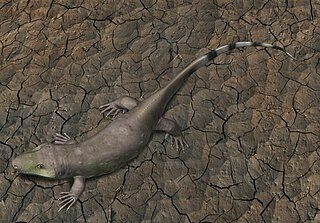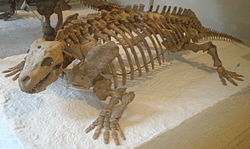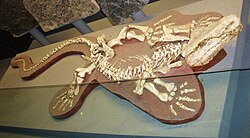
Amniotes are tetrapod vertebrate animals belonging to the clade Amniota, a large group that comprises the vast majority of living terrestrial and semiaquatic vertebrates. Amniotes evolved from amphibian ancestors during the Carboniferous period and further diverged into two groups, namely the sauropsids and synapsids. They are distinguished from the other living tetrapod clade — the non-amniote lissamphibians — by the development of three extraembryonic membranes, thicker and keratinized skin, and costal respiration.

"Labyrinthodontia" is an informal grouping of extinct predatory amphibians which were major components of ecosystems in the late Paleozoic and early Mesozoic eras. Traditionally considered a subclass of the class Amphibia, modern classification systems recognize that labyrinthodonts are not a formal natural group (clade) exclusive of other tetrapods. Instead, they consistute an evolutionary grade, ancestral to living tetrapods such as lissamphibians and amniotes. "Labyrinthodont"-grade vertebrates evolved from lobe-finned fishes in the Devonian, though a formal boundary between fish and amphibian is difficult to define at this point in time.

Reptiliomorpha is a clade containing the amniotes and those tetrapods that share a more recent common ancestor with amniotes than with living amphibians (lissamphibians). It was defined by Michel Laurin (2001) and Vallin and Laurin (2004) as the largest clade that includes Homo sapiens, but not Ascaphus truei. Laurin and Reisz (2020) defined Pan-Amniota as the largest total clade containing Homo sapiens, but not Pipa pipa, Caecilia tentaculata, and Siren lacertina.

Anthracosauria is an order of extinct reptile-like amphibians that flourished during the Carboniferous and early Permian periods, although precisely which species are included depends on one's definition of the taxon. "Anthracosauria" is sometimes used to refer to all tetrapods more closely related to amniotes such as reptiles, mammals, and birds, than to lissamphibians such as frogs and salamanders. An equivalent term to this definition would be Reptiliomorpha. Anthracosauria has also been used to refer to a smaller group of large, crocodilian-like aquatic tetrapods also known as embolomeres.

Diadectes is an extinct genus of large reptiliomorphs or synapsids that lived during the early Permian period. Diadectes was one of the first herbivorous tetrapods, and also one of the first fully terrestrial vertebrates to attain large size.

Diadectidae is an extinct family of early tetrapods that lived in what is now North America and Europe during the Late Carboniferous and Early Permian, and in Asia during the Late Permian. They were the first herbivorous tetrapods, and also the first fully terrestrial animals to attain large sizes. Footprints indicate that diadectids walked with an erect posture. They were the first to exploit plant material in terrestrial food chains, making their appearance an important stage in both vertebrate evolution and the development of terrestrial ecosystems.

Captorhinidae is an extinct family of tetrapods, typically considered primitive reptiles, known from the late Carboniferous to the Late Permian. They had a cosmopolitan distribution across Pangea.

Seymouria is an extinct genus of seymouriamorph from the Early Permian of North America and Europe. Although they were amphibians, Seymouria were well-adapted to life on land, with many reptilian features—so many, in fact, that Seymouria was first thought to be a primitive reptile. It is primarily known from two species, Seymouria baylorensis and Seymouria sanjuanensis. The type species, S. baylorensis, is more robust and specialized, though its fossils have only been found in Texas. On the other hand, Seymouria sanjuanensis is more abundant and widespread. This smaller species is known from multiple well-preserved fossils, including a block of six skeletons found in the Cutler Formation of New Mexico, and a pair of fully grown skeletons from the Tambach Formation of Germany, which were fossilized lying next to each other.

Caseasauria is one of the two main clades of early synapsids, the other being the Eupelycosauria. Caseasaurs are currently known only from the Late Carboniferous and the Permian, and include two superficially different families, the small insectivorous or carnivorous Eothyrididae, and the large, herbivorous Caseidae. These two groups share a number of specialised features associated with the morphology of the snout and external naris.

Westlothiana is a genus of reptile-like tetrapod that lived about 338 million years ago during the latest part of the Viséan age of the Carboniferous. Members of the genus bore a superficial resemblance to modern-day lizards. The genus is known from a single species, Westlothiana lizziae. The type specimen was discovered in the East Kirkton Limestone at the East Kirkton Quarry, West Lothian, Scotland in 1984. This specimen was nicknamed "Lizzie the lizard" by fossil hunter Stan Wood, and this name was quickly adopted by other paleontologists and the press. When the specimen was formally named in 1990, it was given the specific name "lizziae" in homage to this nickname. However, despite its similar body shape, Westlothiana is not considered a true lizard. Westlothiana's anatomy contained a mixture of both "labyrinthodont" and reptilian features, and was originally regarded as the oldest known reptile or amniote. However, updated studies have shown that this identification is not entirely accurate. Instead of being one of the first amniotes, Westlothiana was rather a close relative of Amniota. As a result, most paleontologists since the original description place the genus within the group Reptiliomorpha, among other amniote relatives such as diadectomorphs and seymouriamorphs. Later analyses usually place the genus as the earliest diverging member of Lepospondyli, a collection of unusual tetrapods which may be close to amniotes or lissamphibians, or potentially both at the same time.

Casineria is an extinct genus of tetrapod which lived about 340-334 million years ago in the Mississippian epoch of the Carboniferous period. Its generic name, Casineria, is a latinization of Cheese Bay. The site near Edinburgh, Scotland where the holotype fossil was found. When originally described in 1999, it was identified as a transitional fossil noted for its mix of basal (amphibian-like) and advanced (reptile-like) characteristics, putting it at or very near the origin of the amniotes, the group containing all mammals, birds, modern reptiles, and other descendants of their reptile-like common ancestor. However, the sole known fossil is lacking key elements such as a skull, making exact analysis difficult. As a result, the classification of Casineria has been more controversial in analyses conducted since 1999. Other proposed affinities include a placement among the lepospondyls, seymouriamorphs, "gephyrostegids", or as a synonym of Caerorhachis, another controversial tetrapod which may have been an early temnospondyl.

Limnoscelis was a genus of large diadectomorph tetrapods from the Late Carboniferous of western North America. It includes two species: the type species Limnoscelis paludis from New Mexico, and Limnoscelis dynatis from Colorado, both of which are thought to have lived concurrently. No specimens of Limnoscelis are known from outside of North America. Limnoscelis was carnivorous, and likely semiaquatic, though it may have spent a significant portion of its life on land. Limnoscelis had a combination of derived amphibian and primitive reptilian features, and its placement relative to Amniota has significant implications regarding the origins of the first amniotes.

Solenodonsaurus is an extinct genus of reptiliomorphs that lived in what is now Czech Republic, during the Westphalian stage.

Tseajaia is an extinct genus of tetrapod. It was a basal diadectomorph that lived in the Permian of North America. The skeleton is that of a medium-sized, rather advanced reptile-like animal. In life it was about 1 metre (3 ft) long and may have looked vaguely like an iguana. The dentition was somewhat blunt, indicating herbivory or possibly omnivory.

Orobates is an extinct genus of diadectid reptiliomorphs that lived during the Early Permian. Its fossilised remains were found in Germany. A combination of primitive and derived traits distinguish it from all other well-known members of Diadectidae, a family of herbivorous reptiliomorphs. It weighed about 4 kg and appears to have been part of an upland fauna, browsing on high fibre plants.

Limnoscelidae is a family of carnivorous diadectomorphs. They would have been the largest terrestrial carnivores of their day, the other large carnivores being aquatic or semi aquatic labyrinthodont amphibians. The Limnoscelidae themselves, being close to the ancestry of amniotes, would have been well adapted land animals, but still dependent on anamniote eggs, and possibly having a tadpole stage. Contrary to the more advanced herbivorous diadectids, the teeth retained labyrinthodont infolding of the enamel, and were pointed and slightly recurved at the tip.
Ambedus is an extinct genus of possible diadectid reptiliomorph. Fossils have been found from the Early Permian Dunkard Group of Monroe County, Ohio. The type species A. pusillus was named in 2004. The genus name comes from the Latin word ambedo meaning "to nibble", in reference to its herbivorous diet. The specific name pusillus means "tiny" in Latin.
Desmatodon is an extinct genus of diadectid reptiliomorph. With fossils found from the Kasimovian (Missourian) stage of the Late Carboniferous of Pennsylvania, Colorado, and New Mexico in the United States, Desmatodon is the oldest known diadectid. Two species are currently recognized: the type species D. hollandi and the species D. hesperis.

The Organ Rock Formation or Organ Rock Shale is a formation within the late Pennsylvanian to early Permian Cutler Group and is deposited across southeastern Utah, northwestern New Mexico, and northeastern Arizona. This formation notably outcrops around Canyonlands National Park, Natural Bridges National Monument, and Monument Valley of northeast Arizona, southern Utah. The age of the Organ Rock is constrained to the latter half of the Cisuralian epoch by age dates from overlying and underlying formations. Important early terrestrial vertebrate fossils have been recovered from this formation in northern Arizona, southern Utah, and northern New Mexico. These include the iconic Permian terrestrial fauna: Seymouria, Diadectes, Ophiacodon, and Dimetrodon. The fossil assemblage present suggests arid environmental conditions. This is corroborated with paleoclimate data indicative of global drying throughout the early Permian.





























